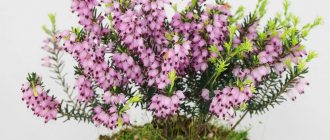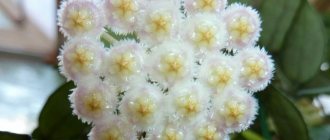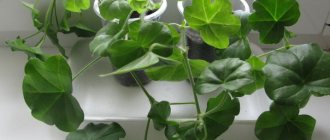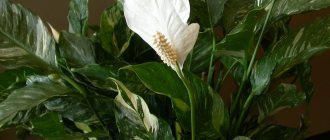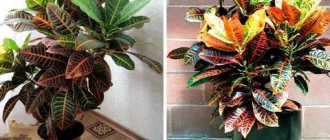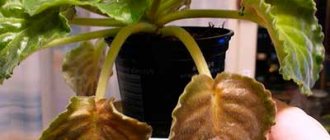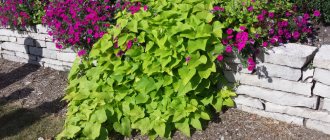Botanical description
Philodendron Xanadu is a perennial, exotic crop native to the Brazilian tropics. In its natural environment, the plant reaches an impressive height (up to 4 m). At home, the compact bush grows no more than 1 m. Large, heavily dissected leaves with white veins add attractiveness to the plant.
In its natural environment, Philodendron Xanadu grows in the form of a shrub. However, if there is a shortage of soil, the plant will behave like a classic epiphyte, clinging to neighboring trees, shrubs and even stones with its aerial roots. This ability of a tropical perennial makes it resistant to any adverse conditions.
Ornamental plant philodendron "Atom"
The most difficult to care for of all the species presented is the Atom philodendron or the compact variety Sello. The ornamental plant has a bright green color and a glossy shine; five-lobed leaves are the main distinguishing features of this species. Very sensitive to the environment, so it is important to provide high humidity levels. Otherwise, the plant dies. It is also important to water the plant constantly, but reduce the amount of watering in the fall. In this case, the water must be settled or boiled. Otherwise, they are as unpretentious as other types of philodendrons described above.
At the initial stages of growth, the trunk is slightly inclined and has aerial roots. It is important to remember that roots are very sensitive to water. Therefore, in search of her, they can easily travel several meters, for example, to an aquarium.
Cost, where to buy
You can purchase spectacular culture in specialized and online stores. In addition, it is possible to buy a plant or exchange it for another on the forums of amateur gardeners.
The price of a one-year-old specimen is about 400-500 rubles, and an adult (large) one reaches several thousand rubles.
Attention! Most companies specializing in the sale of indoor flowers via the Internet deliver goods to all parts of our country. The goods can be paid for by bank transfer or, after receiving the parcel, by cash on delivery.
Reviews from flower growers
One feature captivates me - when the leaves fall and expose the trunk, a white spot with a dot remains in their place and it definitely resembles a human eye. This is such a handy-eyed plant)) and even with antennae)))…
He needs a rather heavy pot, because his root system is undeveloped - single-stemmed - and the upper part can easily pull the bottom and overturn the entire pot. So I gave up plastic ones a long time ago.
keygen
https://otzovik.com/review_476964.html
This handsome guy came to me as a shoot. A very unpretentious flower, as it turned out. Lacking a free pot, I buried it next to an adult monstera, and now they are competing to see who can grow taller. Philodendron successfully covers its aerial roots and the exposed trunk with age. I propagate it from the tops, which causes the main plant to branch, and not just grow upwards. It loves spraying, it is advisable not to place it near heating devices, otherwise the leaves will begin to dry from the edges, and this is immediately noticeable. After all, philodendron is valued not only for its unpretentiousness, but also for its decorative qualities. I recommend it to beginning flower growers. It will not cause you any trouble, but will delight you with its appearance.
Svetka-1502
https://spasibovsem.ru/responses/krasavets-filodendron.html
Philodendron is an unpretentious plant that mainly loves well-lit places; it should not be watered abundantly, but it should not be allowed to dry out the soil. Its design can be varied - you can let it trail along the wall, you can arrange the leaves around a special stick.
Love ( [email protected] )
https://home-flowers.ru/plant183.html
Xanadu varieties and photos
Based on the philodendron with the mysterious name Xanadu, a whole series of related plants has been bred. Each of them is attractive in its own way, because it has a special form of development and coloring of the leaf plates.
Gold
Philodendron Golden fully lives up to its name - the crown is painted in a yellow tint. Large, curly leaves are dissected into 15-20 “fingers”.
Under ideal conditions, the plant forms a dense crown.
Sun
The lush, bright green San Philodendron bush is formed by massive, pinnately dissected leaves located on long petioles.
Young seedlings look less decorative. Their leaf blades are slightly dissected and have a less saturated color.
Micans
An original plant with velvety heart-shaped leaves that changes color depending on the brightness of the light.
The long, fragile stem needs support. However, this becomes optional if Philodendron Mikans is grown as a hanging crop.
Features and origin of the plant
Philodendron is native to the humid tropics of Central and South America. Botanists first paid attention to it in the middle of the 17th century, when its leaves were plucked for a herbarium. Since then, attempts have begun to classify this plant, not without much success.
And only in 1829, the scientist G.V. Schott described the genus Philodendron and gave it its rightful place in the Araceae family. Today this genus includes about 900 species, but not all are well studied.
The word "philodendron" literally means "love tree." It was named so because the plant likes to live in trees. Different species manifest themselves as epiphytes (grow on trees), semi-epiphytes (partially root in the ground, and partly on trees), hemiepiphytes (begin to grow from the ground, then crawl onto trees, after which the earthen roots die).
They have the ability to live and crawl through trees thanks to aerial roots that form in the nodes and internodes. The purpose of the roots is different: thin and short threads are attached to the support plant, and thicker and longer roots are channels for food and drink. A vine cannot exist without support.
Therefore, if in nature a seed sprouted in the ground not near a tree, while growing, the vine crawls towards the shadow of the plant, onto which it later climbs.
The leaves are arranged alternately on the petioles on the stem. They are usually large, but the sizes vary depending on the species: from 11 cm to 1 m. Sometimes in the tropical forest you can find a vine with 2-meter leaves. Leaf color varies from dark green to purple.
But the most characteristic feature is the shape of the leaf plates. It can be very diverse: heart-shaped, arrow-shaped, dissected, finger-shaped and others. The edges of the leaves can be smooth, wavy or jagged. Even on the same flower, young and mature leaves have different shapes.
In addition to the usual ones, philodendron has scale-like leaves called cataphylls. They are designed to protect the buds from which the petiolate leaves grow. Having completed their task, cataphylls often fall off, leaving marks on the trunk.
The stems are fleshy and can be long (2–3 m) or very short, a few centimeters long. With age, the lower part of the trunk becomes woody. The flower looks like a spadix wrapped in a thick waxy blanket, often like a hood. At home it hardly blooms.
Did you know? At the end of the 19th century. During the war between Bolivia and Paraguay, dead soldiers were found several times near one of the large species of philodendron (double-pinnate). It was believed that this tree with an intoxicating smell was a cannibal that killed these people, but the rumors were not true.
Home care
For a good growing season, a tropical crop needs a long day of light (at least 10-12 hours). At the same time, Philodendron Xanadu cannot tolerate exposure to direct rays of the sun, as they cause leaf burn. The plant will be comfortable if it is placed on a windowsill facing the east or west side of the house.
Twice a month, with an interval of 2 weeks, the flower is fed with special complex fertilizers containing microelements.
In the off-season, the air temperature comfortable for the crop should fluctuate between 18-20 °C. In summer and winter, this indicator changes to 21-27 °C and 15-16 °C, respectively.
Important! The heat-loving plant needs high air humidity, especially in the summer heat. Spraying with water at room temperature is necessary for philodendron throughout the growing season. During winter dormancy, this procedure is no longer necessary.
Transfer
It is advisable to replant young plants up to 3-5 years old into fresh substrate every year at the beginning of the new season. Adult plants undergo this procedure much less frequently - once every 2-3 years. If an urgent need arises, the transplant can be carried out at any time.
Reproduction
Layerings and cuttings
Like most philodendrons, Xanadu is easy to propagate by air layering and green cuttings.
For propagation, it is enough to bury the stem with aerial roots into the ground. Or put a cutting with a “heel” and 2-3 dormant buds in water (planted in moist soil).
To speed up the process, seedlings are treated with any growth stimulant (Epin, Kornevin, etc.). Film shelter, which creates a greenhouse microclimate, has a good effect.
Leaf
Rooting of philodendron with a leaf plate occurs according to the standard scheme. In order for this fragment of the plant to grow roots faster, it is separated from the trunk along with a piece of the stem (“heel”).
The cut site is treated with a growth stimulator and only then placed in water or planted in moist soil. Under favorable conditions, after 2-3 weeks, young roots form on the leaf blade.
Reference! In the natural environment, the plant reproduces by self-sowing (seeds). At home, this rooting method is useless, because Philodendron Xanadu almost never blooms in indoor conditions. In addition, insects are needed for proper pollination.
Types of Philodendron
Of the several hundred species of philodendrons, not all can be grown at home. Nevertheless, there are also a lot of indoor varieties. Along with old names, new ones appear every year.
Review of popular types and varieties of philodendrons:
- Warty - a beautiful vine with fragile shoots; the leaves are large (15–20 cm long and approximately 10 cm wide), heart-shaped; the surface of the leaf blade is warty-hairy, velvety to the touch; the color is bronze-green, and the veins are highlighted in a lighter shade;
- climbing (Ivy-shaped) - ampelous type, grows without support in hanging pots: leaves are leathery, dark green, small in size (length 8–15 cm, width 5–10 cm); easily takes root in shaded places;
- Brilliant (micans) is a medium-sized, thin-stemmed vine, easy to care for: the leaves are relatively small (up to 10 cm) and have a velvety surface; the color is green with a reddish tint, which gradually becomes brown;
- Hastate has long narrow foliage (up to 40 cm in length), glossy, soft green in color; the leaves are shaped like spears or arrows;
- Scaly - a creeping plant with large feathery foliage (up to 30 cm in length); new leaves have 3 lobes, and older leaves have 5 lobes, of which 2 rear lobes are much shorter than the others; The reddish petioles have a hairy covering that looks like scales.
- Elegant - single-stem vine: large foliage (45–70 cm), oval, dark green in color; the leaf blade is deeply dissected and looks very elegant;
- Sello, or Double-pinnate, or Double-pinnate, has strong woody stems, which in natural conditions stretch up to 3 m, and in domestic conditions - up to 1.5 m; the leaves are long (60–90 cm), triangular and elongated heart-shaped; foliage strongly dissected, double pinnate;
- Guitar-shaped - a flexible 2-meter vine that needs support; the leaves are shiny, dark green, grow up to 50 cm in length; New foliage has an elongated heart-shaped shape; As it matures, the leaf divides into 3 lobes and vaguely resembles a guitar;
- Evans - an exotic plant with unusual foliage: large (60–80 cm in length and up to 50 cm in width), shiny, triangular and heart-shaped; the color of young leaves is green-brown with bright green veins, and adult leaves are simply green; the leaf blade is solid, but the wavy, curly edges give the impression of pinnateness;
- Radiant — 1.5-meter vine (sometimes reaching 3 m in length); leaves are small (up to 20 cm), dense, very dissected;
- Xanadu (xanadu) - a creeping vine with a woody stem: the leaves are quite large (40 cm), soft, elongated, becoming feathery with age;
- Golden-black Andre - a very beautiful liana, attracts with a wide variety of foliage: new leaves are small (up to 7 cm), heart-shaped, red with a copper tint, older leaves are more than 40 cm in length, more elongated, green with a bronze tint, light veins and lightened edges;
- Martiana is not a climbing plant, but a bushy plant with a lush shape: the petioles of the leaves are thickened, similar to a spindle, up to 8 cm in diameter; the foliage is long (40 or 50 cm), shaped like an elongated heart, shiny;
- Mediopicta, or “Brazil” - a hybrid of the Climbing Philodendron: similar to its climbing “parent”, distinguished by yellow and light green stripes and spots decorating the leaves;
- Red Emerald - compact vine with red shoots and petioles, new foliage of dark red color;
- Imperial Green: dark green leathery leaves with light veins are collected in a dense rosette;
- Goldie Locke: light green foliage with a golden tint, changing color to light green with age;
- Imperial Red (Imperial Red): large rosette of large dark red leaves;
- Burle Marx - a very branched vine from which a bright green ball is formed;
- Ilzemana, or Decorated (ornatum) - an upward vine with ovate and heart-shaped green leaves decorated with silver ornaments;
- Pink Princess: in good lighting, a beautiful pink pattern appears on the leaf plates.
In addition to the listed species, you can find many more interesting hybrids at the flower market: caramel marble, white marble, jungle boogie, lime fiddle, etc.
Diseases and pests
The main reason for the development of plant diseases is improper maintenance conditions or illiterate care. To protect the plant from dangerous infections, it is necessary to comply with the requirements of agricultural technology.
Violation of water and temperature conditions, cold drafts and dry air are the main prerequisites for the development of diseases. And malicious pests - aphids, spider mites, thrips and scale insects primarily damage weakened plants.
Plants, like all living organisms, need careful care. With a minimal investment of time and effort, you can create comfortable conditions for an indoor flower that will preserve its decorative properties for many years.
Useful tips for growing
It is very important to monitor the level of soil and air moisture. Deviations in this regard, namely too dry air and an overdried soil ball, as well as excessively humid air and constantly wet soil, reduce the plant’s immunity, increase the risk of disease and create favorable conditions for the appearance and reproduction of pests.
Did you know? Inside the philodendron there is a milky juice containing rubber. In the plant's homeland, this toxic substance is used to stifle fish and also to seal blowguns.
Philodendron can decorate any room with its exotic grace. And caring for him is not at all difficult. Even a novice gardener can easily cope with this.
Transfer
The root system of a flower develops much more slowly than the above-ground part. Therefore, unless absolutely necessary, you don’t have to replant the flower every year. Just replace the topsoil with fresh, fertile soil and keep the substrate loose. If the soil in the pot is compacted, replant the crop and completely replace the soil.
In adult specimens 4-5 years old, the root system is quite developed and tightly woven into a large lump. To transplant such plants, you can use the transshipment method by replacing the pot with a larger one.
The gaps between the roots and the walls of the container must be filled with fresh fertile soil. The procedure is best carried out in early spring (late March - early April).



